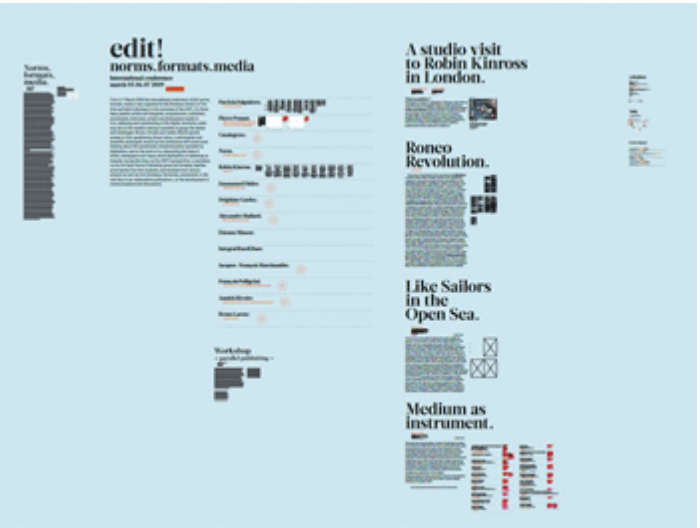FORMAT STANDARD N°3
Rosa B. est le projet de deux institutions artistiques bordelaises qui sont des complices de longue date : le CAPC et l’École des beaux-arts. Qu’on se souvienne de la collaboration engagée en 1996 lors de l’exposition Traffic organisée par Nicolas Bourriaud, ou plus récemment avec One Night Stand, parmi bien d’autres actions et projets menés en étroite association. Ce magazine est un espace commun de réflexion et de discours sur les pratiques artistiques actuelles, un point d’intersection entre les préoccupations des uns pour les questions de transmission du savoir, de recherche, d’expérimentation autour de nouvelles pratiques ou manières de faire et de penser, et les efforts des autres pour définir un projet culturel et artistique précis et innovant capable de répercuter auprès du public, à travers la production d’œuvres nouvelles, d’expositions, de publications ou d’événements, les façons dont aujourd’hui les artistes pensent le monde, s’en emparent et le transforment.
Chaque numéro de Rosa B. portera sur un thème précis, un sujet, une question qui nous semblent travailler nos deux institutions. Ce thème est défini par un comité de rédaction (composé d’enseignants de l’école des beaux-arts et de membres de l’équipe du musée) qui confie à un rédacteur en chef, différent pour chaque numéro, le soin d’articuler une réflexion à travers un ensemble de contributions qui peuvent être textuelles, mais également audio-visuelles.
En choisissant le numérique comme support de création et l’Internet comme mode de diffusion de Rosa B., nous faisons le pari que le web peut amener à faire exister une écriture critique réellement innovante, de nouvelles manières de parler des pratiques artistiques contemporaines et d’en saisir les enjeux, de nouvelles manières de regarder l’art aussi. Nous pensons que l’utilisation des médias actuels et du web (au-delà des questions d’économie et de diffusion qui préoccupent légitimement tous les médias traditionnels, presse papier, radio, télévision, et justifient leur déclinaison sur la toile) ajoutent des temporalités, des espaces, et des dispositifs parfois mieux adaptés que le support papier et le seul texte pour rendre compte de l’art d’aujourd’hui. Nous souhaitons que Rosa B. favorise ces approches plus déliées, plus inventives, moins formatées.
Le troisième numéro de Rosa B, Format standard, dirigé par Patricia Falguières, propose une réflexion sur le graphisme, la typographie, les normes et leurs usages, en se penchant sur les conséquences de l’innovation numérique.
>>> Pour voir le swf, vous devez telecharger le player flash
Format Standard
Thinking about publishing norms, media and formats is usually the poor relative of investigations into technological innovation. Because graphic norms do not seem essential to the development of new technologies. Because norms, in general, are underestimated by thinking about technology and science. Suffice it to note the relative disinterest of researchers, opinion and the media in metrology (the science of measuring systems), for example, which, however, galvanizes the energy of hundreds of thousands of people around the world, and presupposes complex accreditation protocols, involving huge scientific, economic and political challenges. Norms question convention: for it is too often forgotten that a norm is a written document, defining technical specifications for goods, services and processes, which is different from the standard (Windows, for example), which in effect imposes the predominant person involved upon the market, because it is negotiated between the interested parties, and because its brief means that it must be accessible: a norm is a public asset. It is also an item of merchandise, produced by hundreds of certification agencies across the world. So it is an artifact. A norm is constructed, like the standard metre: a product of lengthy and tortuous formulation, and subject to periodical redefinitions. But who draws up the normative agenda? Who has access to the negotiations? Just industrial partners? Users? The powers-that-be?
These questions go well beyond the field of the sociology of science and technology. They stem from what Michel Foucault called “governmentality”: not “the law” or “power”, but those many and varied complex practices which proceed from rational forms, technical procedures, and instrumentation, and format the political arena. Today, normative regulation represents the essence of governance.
Within the realm of norms, graphics and graphic design have a special place. They are the medium of norms (norms are embodied in texts, signs, and formats), and they are themselves a norm. The production of standards and norms lies at the heart of digital innovation, the issue of formats is consubstantial with programming logic. To the various debates under way about standards and digital formats, to open and closed protocols and inter-operability, to what it is possible to perceive of the upcoming development of interfaces and information design, to the prospects opened up by the Open Source, a tsunami of innovations and new social uses (in less than five years, blogs, MySpace, YouTube, Facebook, Twitter, Daily Motion…) brings a new urgency, and puts standards and norms to the test, in a climate of unprecedented tension. This issue of Rosa b., focusing on the international conference held in spring 2009 at the Bordeaux School of Fine Arts, is intended as a contribution to a much needed line of thinking.
Summary
Video archives, “edit! : norms.formats.media”, international conference, march 05.06.07 2009.
Catalogtree, Delphine Gardey, Norm, Emmanuel Didier, Étienne Mineur, Alexandre Mallard, Integral Ruedi Baur, François Pelligrini, Annick Rivoire, Jacques-François Marchandise, workshop ” parallel publishing “, Bruno Latour…
Other works: texts, videos, audios, etc:
Michel Aphesbero, Thomas Boutoux, François Chastanet, Patricia Falguières, Harrison, Robin Kinross, Le Corbusier, Nicolas Maigret, Pierre Ponant, Steve Rusthon.
